#SECOND THAT THEY CHOSE THE DULLEST NAME POSSIBLE just BECAUSE IT STARTS WITH I
Text
They gave a name to Cousin Itt, they went there and gave a name to Cousin Itt. I have excused several things in this series, but I cannot excuse this. This is a crime, a sacrilege, somebody has to pay, somebody has to suffer.
#FIRST THAT COUSIN ITT ALREADY HAD A NAME AND HIS NAME IS COUSIN ITT OR COUSIN ITT ADDAMS IF YOU PREFER#SECOND THAT THEY CHOSE THE DULLEST NAME POSSIBLE just BECAUSE IT STARTS WITH I#ignatius is my foot on their butt#he's name is Itt cousin Itt#wednesday netflix#netflix wednesday#cousin itt
8 notes
·
View notes
Text
Michelangelo’s The Risen Christ: Discovering the sacred in the profane.
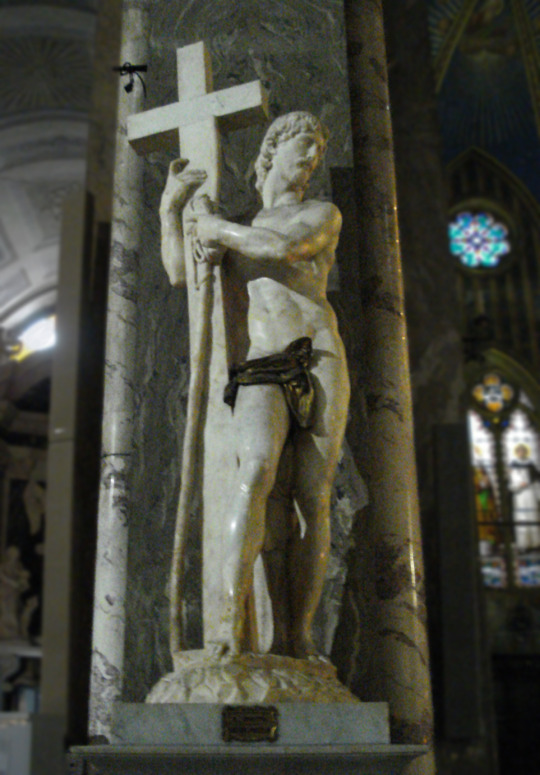
The true work of art is but a shadow of the divine perfection.
- Michelangelo Buonarroti
While a visit to Rome’s grand squares like Piazza Navona is at the top of everyone’s list, there is much more to the Eternal City. The Piazza della Minerva, is one of Rome’s more peculiar squares and is a must-see for lovers of Bernini’s work.
As one of the smaller squares in Rome, Piazza della Minerva holds some interesting sites. Built during Roman times, the square derives its name from the Goddess, Minerva, the Roman Goddess of wisdom and strategic warfare. During the 13th Century, the decision was made to build a Christian Church on top of what was once a square dedicated to a pagan Goddess – and so the church of Santa Maria Sopra Minerva was born, a beautiful example of Gothic architecture and Rome’s only Gothic church.
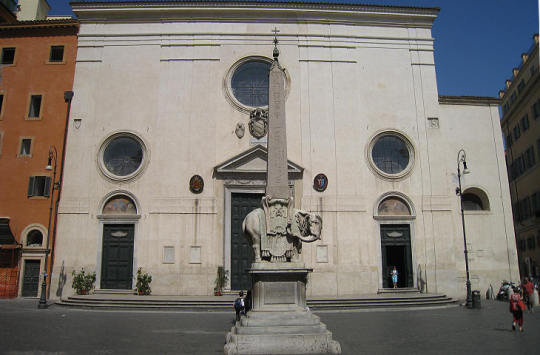
In fact this is the only Gothic church in Rome. It resembles the famous Church of Santa Maria Novella in Florence. There are three aisles inside the church. The soaring arches and the ceiling in blue are outstanding. The deep blue colours dominate the structure while the golden touches promote the intricate design. There are paintings of gold stars and saints. The stained glass windows are beautiful too.
In the centre of the Piazza is an elephant with an Egyptian obelisk on its back, one of Bernini’s last sculptures erected by Bernini for Pope Alexander VII and possibly one of the most unusual sculptures in Rome. There are several theories which aim to decipher Bernini’s inspiration for the sculpture, some of which point to Bernini’s study of the first elephant to visit Rome, while others point to a more satirical combination of a pagan stone with a baroque elephant in front of a Christian church.

Tourists flock to see the elephant but more often than not they miss out visiting an almost forgotten marble masterpeiece by Michelangelo himself inside the church. This controversial statue has resided in the Santa Maria sopra Minerva Church in Rome for almost five hundred years. Indeed The Risen Christ by Michelangelo is one of the artist's least admired works. While modern observers frequently have found fault with the statue, it satisfied its patrons enormously and was widely admired by contemporaries. Not least, the sculpture has suffered from the manner in which it is presently displayed and from biased photographic reproduction that emphasises unfavorable and inappropriate views of Christ.
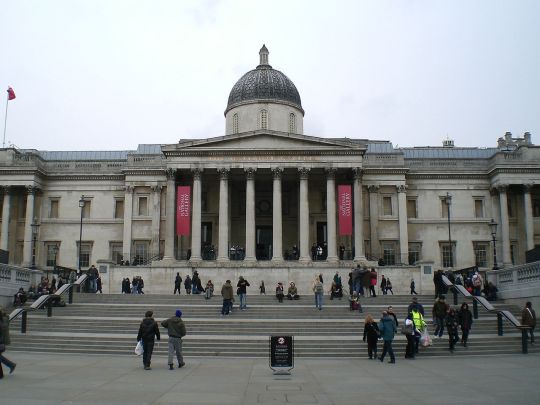
Around 2017 I was fortunate on a visit back to London to see once again Michelangelo’s marble masterpiece, The Risen Christ, which was being displayed in all its naked glory at an exhibition at the National Gallery.
This was another version of this great sculpture that no one has got round to covering up. It has just come to Britain. Michelangelo’s first version has been lent to the National Gallery, in London, for its exhibition Michelangelo and Sebastiano del Piombo in 2017. It came from San Vincenzo Monastery in Bassano Romano, where it languished in obscurity until it was recognised as Michelangelo’s lost work in 1997.

I found it profoundly moving then as I had seen the other partially clothed one on several visits to the church in Rome. It has always perplexed me why this beautiful work of art has been either shunned to the side with hidden shame or embarrassment when it holds up such profound sacred truth for both art lover or a Christian believer (or both as I am).
Michelangelo made a contract in June 1514 AD that he would make a sculpture of a standing, naked figure of Christ holding a cross, and that the sculpture would be completed within four years of the contract. Michelangelo had a problem because the marble he started carving was defective and had a black streak in the area of the face. His patrons, Bernardo Cencio, Mario Scapucci, and Metello Vari de' Pocari, were wondering what happened when they hadn't heard for a while from Michelangelo. Michelangelo had stopped work on The Risen Christ due to the blemish in the marble, and he was working on another project, the San Lorenzo facade. Michelangelo felt grief because this project of The Risen Christ was delayed. Michelangelo ordered a new marble block from Pisa which was to arrive on the first boat. When The Risen Christ was finally finished in March 1521 AD Michelangelo was only 46 years old.

It was transported to Rome and this 80.75 inches tall marble statue was installed at the left pillar of the choir in the church Santa Maria sopra Minerva, by Pietro Urbano, Michelangelo's assistant (Hughes, 1999). It turns out that Urbano did a finish to the feet, hands, nostrils, and beard of Christ, that many friends of Michelangelo described as disastrous). Furthermore, later-on in history, nail-holes were pierced in Christ's hands, and Christ's genitalia were hidden behind a bronze loincloth.
Because people have changed this sculpture over time; many are disappointed with this work of art because it is presently different than the original work that Michelangelo made. The Risen Christ had no title during Michelangelo's lifetime. This sculpture was given the name it has now, because Christ is standing like the traditional resurrected saviour, as seen in other similar works of art.
It was in discussion with an art historian friend of mine currently teaching I was surprised through her to discover the sculpture’s uncomfortably controversial history. There is no doubt Michelangelo’s marvellous marble creation has raised robust debates about where beauty as an aesthetic sits between the sacred and the profane. And nothing exemplifies that better than the phallus on Michelangelo’s The Risen Christ.
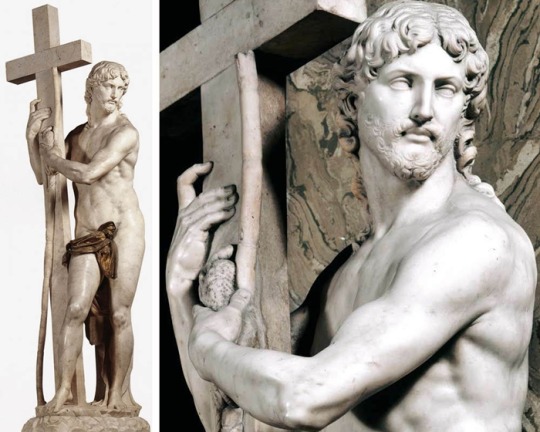
For the majority of its time there, however, the phallus has been carefully draped with a bronze loincloth - incongruous at best, and prudish at worst, but either way a less than subtle display of the historic Church’s discomfort with the full physicality of Christ.
Indeed, it is worth noting that this attitude prevails, at least in some sense, into the twentieth-century: the version of the statue in Rome remains covered to this day, and much of the critical attention the sculpture has received after Michelangelo’s death has been grating. Romain Rolland, an early biographer, described it as ‘the coldest and dullest thing he ever did’, whilst Linda Murray bluntly dubbed the work ‘Michelangelo’s chief and perhaps only total failure’.
But Michelangelo himself saw no such mistake. The censored statue seen in Santa Maria sopra Minerva is what we might call his second draft.
It’s interesting to note that when artist was originally commissioned to sculpt a risen Christ in 1514, he had all but completed it before realising that a vein of black marble ran across Jesus’ face, marring the image of classical perfection which he so wished to emulate. It had nothing to do with the phallus. Furious, Michelangelo abandoned this Christ - the one I saw at the National Gallery - and began again. Even given a fresh chance, he chose to retain Christ’s complete nudity.
Why was this of such importance to Michelangelo? Why did he so strongly wish to craft the literal manhood of Christ, as never depicted before? Part of the answer may lie in his historical context: the Renaissance in Italy was driven in the part by the remains of Roman antiquity discovered there; study of the classics became commonplace, and scholars tended to consider the Graeco-Roman world as a cultural ideal, with ancient art in particular being emblematic of a lost Golden Age. Famously, classical sculpture was almost always nude.

In his interview with The Telegraph in 2015, Ian Jenkins, curator of the British Museum exhibition “Defining Beauty: The Body in Ancient Greek Art”, attempted to explain this tradition. ‘The Greeks … didn’t walk down the High Street in Athens naked … But to the Greeks [nudity] was the mark of a hero. It was not about representing the literal world, but a world which was mythologised.’
We see evidence for this trend in Greek literature as well as sculpture: Homer’s Iliad and Odyssey, considered by some to be the earliest known works of Western literature, were likely written between the 8th and 7th centuries BC, but their setting is in Mycenaean Greece in the 12th century. The Greeks believed that this earlier Bronze Age was an epoch of heroism, wherein gods walked the earth alongside mortals and the human experience was generally more sublime. In setting the texts at this earlier stage in Greece’s history, Homer echoes the belief held within his contemporary society that mankind had been better before (what we might now call nostalgia, or, more colloquially, “The Good Old Days syndrome”). There is a real feeling of delight present in the distance Homer creates between his actual, flawed society, and the idealised past.
Indeed, it calls to mind a line I once read in an introduction to L.P. Hartley’s The Go-Between, by Douglas Brookes-Davies: ‘Memory idealises the past’. Though modernist texts such as The Go-Between problematise this, in antiquity it was not only commonplace but celebrated to look back to a more perfect existence and relive it through art. The very fact that Michelangelo abandoned his sculpture after years of work on account of a barely noticeable flaw in the marble is evidence that he, too, was striving towards the classical ideal of perfection. ‘Unfortunately,’ Hazel Stanier has commented, ‘this has resulted in unintentionally making Christ appear like a pagan god.’

This opens up another question – why does such a rift exist between the way ancient cultures envisaged their divinity and our own conceptions of a Christian God? Why are we not allowed to anthropomorphise the deus of the Bible in the same way that the Roman gods were?
Christ, of course, makes this somewhat confusing, given that he is described in the Bible as ‘the Word made flesh’, a physical and very human incarnation of the spiritual being that we call God. Theology tells us that he is fully human and fully divine, and yet the Church have excluded him from many aspects of life that a majority of us see as typifying a human being. Christ has no apparent sexual desires or romantic relationships, and though not exempt from suffering, he does not play any part in sin (which, as the saying goes, is ‘only human’). I think that the enormous controversy caused by films such as The Last Temptation of Christ (1988), which explore the possibility of Jesus having a sex life, is reflective of the possibility that - though in theory the Christian messiah is fully human - we feel significant discomfort at the notion that he may have explored particular aspects of the human experience.
Purists and the prude and liberals rush to opposite sides of the debate. If purists run one way to completely deny Christ had any sexual desires or even inclinations as all humans are want to do, liberals commit the sin of rushing to the other extreme end and presuppose that Jesus did act on sexual impulses simply because it was inevitable of his human nature.
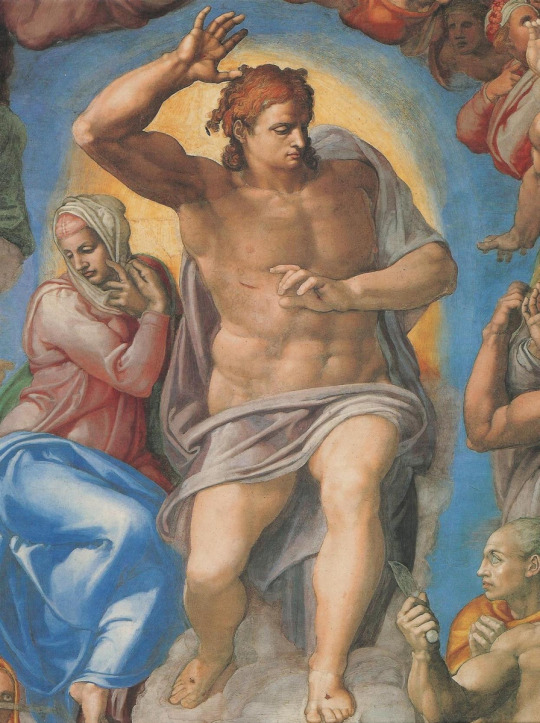
I think the truth lies somewhere between but what that truth might actually be is simply speculation on my part. It doesn’t detract for me the life and saving mission of redemption that Jesus was on - to suffer and die for our sins as well as the Godhead reconciling itself to sacrificing the Son for Man’s sins and just punishment.
Of course, it is well-known that the classical gods had no qualms about sexual activity. It is difficult to make retrospective judgements about citizens’ opinions on this but, as it was the norm, we might assume that they felt it was rather a non-issue. I can empathise with some critics who reason that the Christian God is not entitled to sexual expression is because of the traditional Christian idea that sex is inherently sinful – that original sin is passed on seminally and so by having sex we continue to spread darkness and provoke further transgression. It is from this early idea that theological issues such as the need for Mary to have been immaculately conceived (she was not created out of a sexual union, much like her son) have stemmed. But here - the immaculate conception - the critics are profoundly wrong in their theological understanding of why God had to enter the world as Immanuel in this miraculous way.
Some Christian critics - and I would agree with them - assert that the vision of a naked Christ might make a powerful theological point in a world where sex still carries these connotations. They rightly point out that clothing - and I might extend this to mean the covering-up of the sexual parts of our body - was only adopted by humankind after the Fall, the nudity of Christ is making a statement about his unfallen nature as the second Adam. In other words, Christ has no shame, because he is sinless and has no need for shame. Perhaps what Michelangelo intended was actually to disentangle nudity from its sexual, sinful associations, instead presenting us with a pre-lapsarian image of purity taking the form of the classical Bronze Age hero.
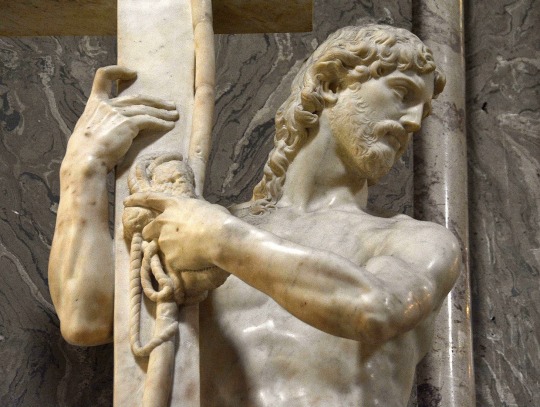
There is another, less theological explanation for the sculptor’s obvious use of the classical form. It reminds us of a time when gods walked the earth alongside us, when they were fully human – us, only immortal. Maybe he wanted to emphasise that fully human aspect of Christ’s being. Questionable as much of their behaviour was, the classical gods were certainly easy to identify with. For Michelangelo, this may have been his own way of embodying John 1:14 in marble: ‘The Word became flesh and made his dwelling among us’.
It is here critics may have gotten hold of the wrong end of the stick with The Risen Christ when they point out the odd proportions of the figure: that it has a weighty torso, or the broad hips atop a pair of tapered and rather spindly legs, or even a side or rear view of the figure that show Christ’s buttocks.
For a start, this ungainly rear view was not supposed to be seen. The statue was meant to go in a wall niche, so that the back of the statue was hidden. Michelangelo of course knew this, and shaped the statue so that it would appear well proportioned from the front. If we view the sculpture from the front left, perhaps its best side, then Christ is no longer a thickset figure. Rather, his body merges with the cross in a graceful and harmonious composition.
The turn of Christ’s body and his averted face suggest something like the shunning of physical contact that is central to another post-Resurrection subject, the Noli me tangere (“Touch Me Not”). The turned head is a poignant way of making Christ seem inaccessible even as the reality of his living flesh is manifest.
We are encouraged to look at not Christ’s face, but the instruments of his Passion. Our attention is directed to the cross by the effortless cross-body gesture of the left arm and the entwining movement of the right leg. With his powerful but graceful hands, Christ cradles the cross, and the separated index fingers direct us first to the cross and then heavenward. Christ presents us with the symbols of his Passion – the tangible recollection of his earthly suffering.
Behind Christ and barely visible between his legs we see the cloth in which Christ was wrapped when he was in the tomb. He has just shed the earthly shroud; it is in the midst of slipping to earth. In this suspended instant, Christ is completely and properly nude.

We must imagine how the figure must have appeared in its original setting, within the darkened confines of an elevated niche. Christ steps forth, as though from the tomb and the shadow of death. Foremost are the symbols of the Passion, which Christ will leave behind when he ascends to heaven.
Why was Michelangelo compelled to portray Christ completely naked in a way that was bound to trouble some Christians? It was not out of a desire to blaspheme. On the contrary, this genius – poet, architect and painter as well as the greatest sculptor who has ever lived – was not only a faithful Christian but someone who thought deeply about theology. You can bet he had good religious reasons to depict Christ in full nudity.
But it would be complacent to think there was no tension in showing Christ nude. The fact that The Risen Christ in Santa Maria still has its covering proves how real those tensions are. The fundamental reason Michelangelo could get away with it was that he was Michelangelo. By the time he created this statue, he had the Sistine Chapel ceiling (with all its male nudes) under his belt and was the most famous artist in the world.
For centuries, the faithful have kissed the advanced foot of Christ, for like Mary Magdalene and doubting Thomas, they wish for some sort of physical contact with the Risen Christ. To carve a life-size marble statue of a naked Christ certainly was audacious, but it is also theologically appropriate. Michelangelo’s contemporaries recognised, more easily than modern viewers, that the Risen Christ was a moving and profoundly beautiful sculpture that was true to the sacred story.
#the risen christ#michelangelo#marble#church#christian#beauty#aesthetics#statue#religious#renaissance#history#rome#bernini#art#arts#culture#society#religion#sculpture
201 notes
·
View notes
Text
Klaine one-shot “Consequences” (Rated NC17)
Summary: At a formal dinner thrown by a good friend, Kurt encounters a man he'd rather forget existed. He handles the situation with his signature cool, but his pet might not be quite so disciplined. (2529 words)
Notes: Okay, so, right off the bat, there are a few things I will admit are slightly problematic about the way Kurt and Blaine handle things here, but I know people like Kevin personally, and sometimes, a good old-fashioned revenge fic can make your day xD Plus, before anyone comes at me about hating switches, that isn't what this fic is about. I love switches. I know tons of them. But I also know people in the kink community who's behavior give switches a bad name. Kevin happens to be one of those. Dom Kurt, sub Blaine
Part 69 of Taking a Journey Together
Read on AO3.
“Why, if it isn’t Kurt Hummel!”
Those words slide unappetizingly through several sour notes of a single rusty octave range, volleying towards their target (in this case, the back of Kurt’s head) and striking with the messy precision of a hot mustard sandwich.
“Well, well, well …” The distastefully tipsy voice becomes louder as its owner slinks closer “… look who the cat dragged in! Aren’t you a sight for sore eyes?”
Blaine, holding his Master’s drink with eyes trained on the floor, feels Kurt sigh through every fiber of his being from four feet away.
“Well, well, well, if it isn’t Captain Cliché. God save us all,” Kurt mutters under his breath. He reaches for his drink - a half filled glass of champagne – which Blaine obediently hands over, and knocks it back in one gulp.
Blaine takes the empty glass, prepared to hand it off to the next serving slave that passes by. He keeps his eyes lowered, disallowed to lift them as a submissive, but he doesn’t need to see this man to know who he is, though they’ve never been introduced.
Kevin Dale.
Not Kurt’s only ex, but the dreaded ex.
Blaine knows all about him. He’s the only sub Kurt had who doesn’t gush over him the way his other subs do. Worse, he does anything he can to cut Kurt down behind his back. He identifies as a switch, and is more than likely painting himself as a Dom for this particular occasion, which is why he can approach Kurt like they’re equals. He’s an egotistical ass who is more into fetish than BDSM, but he’s also an attention whore - a difficult thing with Kurt by your side. It’s one of the reasons Blaine can travel in BDSM circles with his Master and not worry too much about being noticed for who he is in real life.
On Broadway, Blaine’s the star, but in this arena, all eyes are on Kurt.
And even if they weren’t, they should be, because Blaine’s Master looks stunning.
They’re attending the first formal dinner they’ve been able to go to since Blaine started his new show. The dress code is evening gowns and tuxedos for the Dominants, clean-cut and slightly more casual attire for the subs - anything from the grey dress slacks and eggplant cashmere sweater Blaine has on to completely nude and collared applies. Blaine doesn’t have permission to look in the faces of the Dominants around him, but there’s two things he can tell about Kevin off the bat without looking:
The man is leering at his Master like a cat staring at a plump pigeon perched too high out of his reach.
And he’s drunk as a skunk.
Which leaves Blaine with a lot of questions, first on his list being where did their host go? It stated quite clearly in the invitation that it was against the rules to get drunk at this function. Inebriation was grounds for immediate removal.
Someone should have carted Kevin out of here a bottle of champagne ago.
“Oh, Kevin,” Kurt says, frustration embedded in his tone. “And just when I thought I’d never see you again.”
“Looks like today’s your lucky day!” Kevin slurs, but his attention wanes quickly when he sets eyes on Blaine. “And look who we have here!”
Blaine can’t see when the man’s eyes find him, but he knows his gaze lingers. He feels it like oily fingers trailing down his skin. He shivers in disgust.
“I heard you had a beautiful new boy, but I didn’t realize he was that beautiful.”
“Yes, he is. I’m incredibly lucky. And before you ask, no. I don’t share.”
“I wouldn’t even think of it,” Kevin replies, but to Blaine’s ears, he sounds disappointed. “I’d have no way to reciprocate.”
“So, you’re still unattached?” Kurt asks. To the outside observer, it would sound like small talk, but Blaine knows his Master took a dig.
“Sadly, yes. I’m far too busy to deal with anyone these days – Master or sub.”
“Pity,” Kurt grumbles, grabbing another glass of champagne when a tray passes by. “And yet you managed to find time in your schedule to show up here. To what do we owe the honor?”
“What’s the good of being part of the kink community if you don’t mingle from time to time? And being single is, uh … a great time to mingle.”
Kurt takes a possessive step in front of Blaine, a sign that Kevin must have given Blaine another lecherous once over. But Kurt changing positions draws Blaine’s gaze to his right, to his Master’s hip and Kevin’s hands gesticulating in and out of his line of sight. That’s when he sees it – a gold chain on Kevin’s wrist holding a complicated silver key. Blaine has seen those kinds of keys before. He knows what they’re for.
Kevin having one doesn’t make sense.
Kurt notices it, too, when Kevin dramatically reaches for his own glass of champagne, flashing it before Kurt’s eyes, waiting for Kurt to mention it. “So, you’re a key holder now?”
“Yup.”
“But I thought you said you didn’t have time for anyone.”
“I don’t.”
“So … whose is it?” Kurt sounds downright exhausted when he asks, but Blaine knows why he does. Not because Kurt cares who Kevin’s seeing, but because he wants to make sure that any soul who turns themselves over to Kevin’s quote-unquote care, even casually, knows what they’re getting themselves into.
“My own.”
Kurt’s breathing stops short in a shocked way that makes Blaine want to laugh, but he holds himself together.
“Come again?”
“I couldn’t find anyone worthy of being my key holder so I’m doing it myself.”
“O-kay.” As a masochist himself, Kurt can’t judge. He has a cage of his own. Several, if he’s being honest. There are many things he does to himself that stricter purist Dominants would consider crossing a line into submission. And Kevin’s a switch. Different rules apply. Still, what Kevin does, he does mostly for show, so Kurt would face palm himself if it were socially acceptable. “Whatever floats your boat.”
“Yup. I bought the heaviest, most restrictive cage I could find. Expensive, too,” he exposits even though no one asks, grabbing himself in the crassest way possible to emphasize his point. “It’s special made to my specifications, one of a kind, with only the one key.” He holds up his wrist, dangling the key in front of Kurt’s face like some sort of enticement. “I’d have to go see a locksmith if I lost it. Maybe even the ER.”
“You don’t say.” Kurt grabs another flute of champagne when another tray goes by out of habit now, sounding less interested in this conversation than he would talking about the average velocity of snot traveling through space. “You’d better pray it doesn’t go astray then.”
“The only way someone’s going to get ahold of this baby is to cut off my hand.” Kevin growls, sounding excited that someone might actually fight him over that key. Maybe he’s hoping Kurt will just so he has an excuse to mess with him again.
The assumption that he could sets Blaine’s back teeth on edge.
Kurt sighs. Blaine knows that sigh. It’s Kurt’s beyond done sigh. “Well, as exciting as this has been, I’m afraid it’s about time that my pet and I run along.”
“Ooo,” Kevin coos, stepping purposefully in Blaine’s way as they begin to walk off causing Blaine to run into him. “Feel like moving this party somewhere else, then? Somewhere more intimate?”
“Not in the slightest.” Kurt takes Blaine’s elbow and maneuvers him around the swaying bastard grinning in front of them. “You stay here, Kevin. Here ...” He thrusts his untouched glass of champagne in the man’s hand “… have a drink. I’m going to find Adam and confer with him about the caliber of his guest list. Have a lovely rest of your evening.”
“You as well, mon ami,” Kevin says with a clumsy wave, watching Blaine’s ass in particular as the two men leave, hand lewdly reaching for his caged cock again.
***
“Jesus Christ! That was the longest, dullest dinner Adam has ever thrown!” Kurt laments, shoving Blaine against the first wall he can find the second they walk through their hotel suite door. “I don’t know why he chose to change party planners, but they had no clue what they were doing!”
Blaine doesn’t get a word in before Kurt claims his mouth and kisses him hard, smacking the back of his head against the drywall. Not that he would have said anything … or had permission to speak. None of that matters anyway because he enjoys this – enjoys Kurt’s control, a control he doesn’t even have to surrender to. One only needs to surrender control when they have it, and as Blaine’s control is limited, there’s nothing to surrender. He just gets to be and that’s all he really wants.
“You know, I thought our evening was shot when that asshole Kevin showed up, but with you there …” Kurt breathes his pet in deep, letting the clean smell of Blaine’s skin fill his nose and mouth “… you make it all bearable.” He grins against his pet’s lips, crowding him further against the wall even when there’s no more room, pressing the whole of his body against him. “You were such a good boy tonight, pet.” Kurt giggles, reaching for the buckle to Blaine’s slacks. “Such an obedient boy. I think that deserves a reward. Don’t you?”
“I …” Blaine squeaks. God! Now is so not a good time to speak up, but he has to! If his Master finds out he was keeping something from him after receiving a reward, Blaine won’t see another one until the year’s out. And it’s only February. “Sir, I have a confession to make. An important one.”
“Oh?” Kurt steps back, annoyed at the interruption, but mostly at the idea that his pet may have disobeyed him behind his back. “And what’s that, pet? Tell me now.”
But Blaine doesn’t say another word. He reaches into his pocket and slowly pulls out a gold chain. He holds it up in front of Kurt’s face, gulping down air with a dry throat, aware that this might have serious consequences. Kurt’s eyes spring open wide.
The gold chain twists in front of his eyes from the weight of a single silver key.
A complicated key.
A familiar looking key.
“What the …?” Kurt stares at Blaine, surprise mixed with confusion swirling within his gaze. “When did you …?”
“I … I didn’t, Sir. Not intentionally. When Kevin bumped into me on the way out, the clasp must have caught on to my sweater and broke. It was stuck to my sleeve. I didn’t notice until we were in the parking lot. I suppose I could have told you in enough time to return it, but I ...” Blaine’s bottom jaw snaps shut, and with it, Kurt’s already wide eyes open further.
“But what, pet? Finish.”
“But I …” Blaine inhales in and exhales out, mentally preparing to end this night taking whatever punishment his Master sees fit to give him. “I don’t like Kevin. I don’t like the way he talked to you. I don’t like the way he talks about you. I don’t like the fact that he disrespects you. You’ve told me how he acted when the two of you were together – how he insulted you, manipulated you. Obviously, he hasn’t changed. I know that those concerns shouldn’t be mine, and that I should just obey. You give me rules, and I should follow them without question. But I wanted to get back at him. And this seemed like a fitting way.”
Kurt grabs the chain from Blaine’s hand and examines the clasp, not because he doubts his pet’s version of events, but so he can grasp the extent of what happened. He holds the chain closer to his eyes and sure enough, the clasp has snapped, rendering it permanently open. Kurt muses over this turn of events, contemplating what he should do, how he should handle Blaine. Considering the condition of the chain, it’s not really Blaine’s fault.
And yes, Blaine shouldn’t carry those concerns. They’re for Kurt to bear. But Kurt can’t punish Blaine for his loyalty. That would be like setting him up to fail. Kurt confided in him to begin with. Did he expect his loyal pet, this man who loves him unconditionally, to be able to push those things aside without any opinion on them whatsoever?
Kurt isn’t able to. Blaine has confided in Kurt, too, about demon exes from his past. Kurt hasn’t set any of that information aside. On the contrary, he’s created a hit list of sorts. On occasion, he takes it out, Googles a name, looks at a picture, memorizes information, dreams about the kinds of punishments he’d dish out if the two ever crossed paths …
Blaine shouldn’t disrespect a Dom by keeping his key from him. Losing keys are anxiety fuel for Kurt. But no one they know really considers Kevin a Dom worthy of respect anyhow.
Very few people consider him a Dom at all.
According to Adam, the man wasn’t invited to his soiree tonight. He finagled himself inside by taking advantage of his overwhelmed party planners – another point against him.
But regardless of feelings and people’s opinions, in the end, Kevin should have opted for a sturdier chain to carry his super important key.
The irony of Kurt finding himself unexpectedly becoming Kevin’s key holder makes a grin burn from cheek to cheek.
“You know, I should probably be upset at you for this,” Kurt says, unable to keep the snicker out of his voice. “And you’re right. The responsible thing would have been to tell me about this earlier, when I could have done something about it.”
“I know, Sir,” Blaine says, pressing his chin to his chest to hide the smile that won’t go away, relieved when he hears his Master’s playful tone. However Kurt decides to punish him over this, Blaine will deserve it.
But for the moment, he feels fucking great.
“Stay here, pet, while I take care of … this,” Kurt says, sneering at the key, thoughts of having to see the distasteful man again sullying his mood.
“Yes, Sir.” Blaine assumes Kurt will put the key safely away and text Kevin about it, letting him know when and where he can pick it up. After all, that’s the responsible thing to do. Kurt crosses the room to the bathroom and disappears behind the door. The next sound Blaine hears is the toilet flushing. Kurt comes out, brushing his hands together, the chain and key nowhere to be seen.
“Master?” Blaine says, raising an eyebrow.
“You know nothing, and neither do I, pet,” Kurt declares, returning to the matter of Blaine’s belt buckle. “Are we clear?”
“Crystal, Sir,” Blaine says, biting his lower lip the second Kurt slips his hands downs his pants.
“So,” Kurt hums, vibrating with satisfaction, “where were we …?”
30 notes
·
View notes
Photo

Secrets of the Six Wives: Catherine Parr - To be useful in all that I do:
Henry VIII’s last wife was a keeper, but she was also someone who walked a dangerous path and often had to choose pragmatism over idealism. On the one hand, she saw herself as one of the top Evangelical leaders, someone who had been chosen by God to spread the true faith on England. On the other, she was also a woman who -like any other- wanted to be loved. After two marriages, and being a widow yet again, she wanted to marry for love. She caught the eye of two men, one the dashing Thomas Seymour, uncle to the future King, Edward VI, and brother to the late queen, Jane Seymour; and Henry VIII.
“He craved female company. It was time for yet another new wife.”
Dr. Lucy Worsley mentions that Henry might have still entertained the possibility of having a “spare” born out of his new wife, to further secure the Tudor Dynasty. While this is a strong possibility, it is likelier that Henry chose Catherine Parr because she saw someone who was the ideal wife, but one he could have intellectual conversations with.
Time however, hasn’t been generous to Catherine Parr.
“She might have a reputation for being the dullest of them all. But the real Katherine was far more intriguing. She loved music and dancing … She was actually quite glamorous. She spent lots of money on sumptuous gowns … The Princess Elizabeth spent a lot of time learning from her on how to be a queen, in matters of image, and intellectually. Katherine was real role model.”
I couldn’t have said it better myself. Not only that but as soon as she became Queen, she started to surround herself with like-minded women. Smart, well-spoken women. She became a role model for many young girls, among them the future Virgin Queen, lady Elizabeth Tudor and her cousin, lady Jane Grey.
In her, they saw someone who knew how to play the game via her sweetness, using her public image and religious devotion to her advantage, and not being afraid to challenge others.
Knowledge is power, goes the old saying and there is no better example of this than Catherine Parr. Here was a woman who was outspoken, but who knew when to speak, and how to defend herself. At the same time, her religious devotion made her one of the strictest mistresses in Tudor history. While having as many jewels, clothes and (especially) shoes as any young woman could ever want, she also cut back on some of her expenses, and emphasized on moral virtue to all of her ladies.
“More companion and mother figurehead to his children.”
Indeed, she was. And you know how you always have those special friends who despite having different opinions than the general population, they always find a way to be everyone’s best friend? Catherine Parr was one of those people. Her mother was featured in the first episode of “Secrets of the Six Wives”. Lady Maud Parr nee Green had served Queen Katherine of Aragon. Catherine Parr’s family remained loyal for the most part to Henry VIII’s first consort. It is possible that she was named after her, a mistress that her mother had grown very attached to.
“She was the definitely the MOST INTELLECTUALLY curious of his wives. She was one who couldn’t stop reading books.”
Catherine of Aragon made education for women fashionable, so following her lead, lady Maud made sure that her daughter received the best education that a lady of her station could have. Despite being a devout Catholic, Catherine Parr had always been intellectually curious and it was that curiosity that got her to explore the new ideas that had come from across the continent into England. She became a staunch Reformer, and she encouraged her ladies, especially her youngest stepdaughter to read forbidden books and translate old texts. And it wasn’t just them, but one of her best friends at court was none other than the lady Mary, Henry VIII’s eldest daughter, who was motivated enough to translate one of the gospels in the new testament into English.
Another thing that Dr. Lucy Worsley doesn’t fail to mention is that no other woman in English history, let alone a royal consort! Had enjoyed the sort of literary success that she did. Yes, Queens translated texts. Some Kings’ mothers were awarded great titles and given precedence over other ladies. Margaret Beaufort and Cecily Neville are proof of that. Both women translated books and were renowned for their religious devotion, but none would have ever dreamed of being a published author, let alone the voice of a new religious movement that was taking England by storm.
Catherine became that and more. She published her first book in 1545. It was called “Prayers and meditations”. This book was translated by her stepdaughter, as well as Marguerite of Navarre (who often favored many reformers, but at that time had to lay low because she was already a suspect of France’s conservative faction) “Mirror of the soul”, into English and given to Henry VIII as a New Year present in 1546.
Catherine however, was playing with fire. It isn’t mentioned, but following Anne Askew’s arrest, Catherine knew that it was only a matter of time before they got to her too. She hid her books, disposed of most of them and did the only thing a woman in her position could do: Beg.
She caught Henry by surprise, reminding him of her eternal devotion to him and the Anglican Church he had established. She then used the victim card and played the fool. Since she was a woman, could she be to blamed for her follies? She wanted to debate because she wanted to be certain of what religious path to take, and if she made Henry, then she was sorry, but as a woman, she was curious and feeble, and therefore she needed someone intellectually superior to set her right.
Henry was touched and Catherine no longer had anything to worry about. From that point until his death, Catherine kept her religious views to herself.
A year after Henry died, she published her second book, which also became a bestseller. “Lamentations of a sinner”. Henry was depicted as Moses leading his people to the promised land, away from Egypt which is the Roman Church, that had long kept England in bondage. Now that everyone was ‘free’, they could have access to the word of God in their native language, and not be punished for it. The new King was after all a devout Protestant and as Dr. Worsley pointed out, someone who never stopped favoring his beloved stepmother, whom he considered his true mother.
Besides Catherine of Aragon, a woman that Dr. Worsley refers to as "the warrior queen", Catherine Parr was the only other Tudor consort to be left in charge of England after her husband had gone away, to seek glory in France (yet again).
As regent, Catherine Parr had unlimited authority. She still had to answer to parliament, but she could give orders and sign bills as if she were the King. That is how much Henry VIII trusted her. Her youngest stepdaughter no doubt saw how well she handled herself, and used what she learned during her brief regency, for when she became Queen Regnant.
Sadly, Catherine Parr's story didn’t have a happy ending. Dr. Lucy Worsley skims through her story, saying that after she finally gave birth to her first child, she died of puerperal fever, commonly known as childbed fever. The same thing that killed Henry VIII’s mother and his third wife, killed her. But there is also something darker that contributed to her physical decay and that was the stress of finding out that her husband fancied her stepdaughter. She sent her away and reminded her to guard her virtue above all else, the rest as they say is history.
Catherine Parr was survived by her adventurous husband and their baby daughter, but not for long. In her biography of Catherine Parr, Linda Porter mentions that it is highly unlikely that Lady Mary Seymour, named after her mother’s eldest royal stepdaughter, lived past the age of two. There is no record of her after her father was beheaded, and she went into the Duchess Dowager of Suffolk’s household not long after. There is even a poem that laments both her death and her mother’s and makes mention of Lady Mary Seymour’s untimely death, suggesting that she died when she was still an infant.
A sad end to a woman who was one of England’s leading intellectuals. But one who isn’t forgotten. In her recent book on the Tudors and Stewarts, Linda Porter highlights the contribution that Catherine Parr made to England through her royal stepdaughter, Elizabeth Tudor. Like her, when she used her wit, so Henry would spare her, Elizabeth I used the rules that were meant to keep women down to her own advantage. In her Tilbury speech, she said that she had the weak and frail body of a woman, but the heart of a King “and a King of England” at that! She won the crowds through her femininity, using her words as her shield, and her propaganda as her sword.
Recommended reading: Katherine the Queen: The remarkable life of Katherine Parr, the last wife of Henry VIII/ Tudors vs Stewarts: The Fatal Inheritance of Mary, Queen of Scots by Linda Porter; The Six Wives and the Many Mistresses of Henry VIII by Amy Licence, the Wives of Henry VIII by Antonia Fraser and Elizabeth: The struggle for the throne by David Starkey (Although Starkey believes that she wasn't a reformer by the time that she became Henry's wife, he does highlight her contributions to the Protestant faction in England and how she became a role model for Elizabeth, Jane Grey and Edward VI).
8 notes
·
View notes